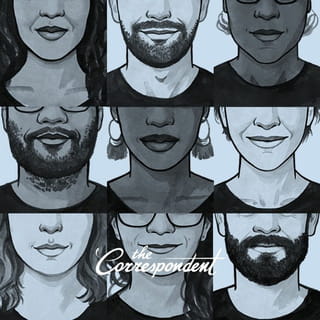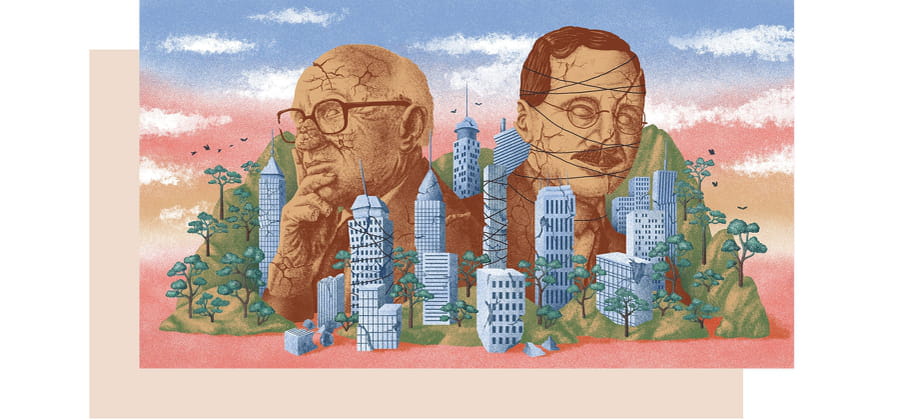
Has it been a year already?!
In 2018, the founders of a member-funded Dutch media platform wagered that there would be demand beyond their home country of the Netherlands for deeply considered, beautifully presented, ad-free journalism that broke free of the tyranny of the 24-hour news cycle. Enough demand to launch De Correspondent in English, and so they proceeded to test out that hypothesis.
They weren’t wrong. By the end of that year, 48,933 people had joined their movement for unbreaking news. I was among them.
It would be another nine months before The Correspondent would launch. This time I wouldn’t just be an ardent supporter; I would be helping to recruit a team of 13 – eight of us sharing office space and learning from our colleagues in the Amsterdam-based newsroom, who by this point had six years of doing what we were about to attempt. Our first five correspondents were strewn out across the globe, from the US to India, via Nigeria, Great Britain and Italy.
In a world full of cynicism (and few professions have more cynics than journalism), ours is an unashamedly idealistic, ambitious project. We believe unwaveringly that quality journalism can change how people see the world around them, their place in it and what can be done about the colossal challenges we all face.
We also believe that good design should “cultivate calm” rather than distract the reader, and that the creative on the page needn’t be a lazy selection of stock images. Rather, when carefully considered, photography, illustrations, data visualisations, video and audio can elevate and add layers of depth to a story. They can even be the story.
We are driven by a belief that journalistic transparency – where the journalist is both open about having a point-of-view and willing to share their learning curve, which means informing readers when that point-of-view changes – can help build trust. We’re convinced that when enabled and incentivised to do so, people will lend their expertise, experience, networks, knowledge and time to help us tell better stories. Last but not least, we believe that people are willing to pay for this, not as consumers of a product but as supporters of a mission to make the world better through furthering our collective understanding of it.
Like I said: unashamedly optimistic and idealistic.
On 30 September 2019, The Correspondent cast off, publishing the mission statements of our five English-language correspondents, and then proceeding to figure out in real-time how we’d live up to the promises of the crowdfunding campaign.
In this, our very first editorial report, I intend to give you an overview of that year, sharing what we’re most proud of having achieved, as well as some of the thought processes and decision-making that have informed our journalism over the past 12 months.
With goals as ambitious as the ones we set for ourselves, while we are firmly on the right track, we’ve only taken our baby steps in the direction we wish to travel, and so there are also lessons to share that we’ve learned along the way. A movement is a community and we would not be a very effective one if we don’t also reflect transparently on our interactions with our members since launch.
Here’s the overarching message
It’s been a rollercoaster year. When, in January, founding editor Rob Wijnberg declared that March would be a “viral month” – speaking to his desire to create buzz around our journalism – he could not have predicted just how right he’d be, albeit in a very different way.
There’s been much to celebrate since September 2019, from insightful stories to member growth and, most recently, the launch of our brand new audio app. But we’re only just getting started.
Because in a year when crises have spanned the globe and misinformation has spread faster than solutions, when the news has overwhelmed and depressed and much of the media seemed to do little more than fuel polarisation, it has been absolutely crystal clear that the mission of The Correspondent remains as relevant today as it ever did.
We have work to do.

A year of publishing unbreaking news
By design, the journalism of The Correspondent is determined in large part by our journalists themselves. They are the “conversation leaders”, as we call them, knowledgeable about their beat, developing a strong sense of what stories need to be told – informed by their sources, their interests, their research, their "communities of concern", and, of course, by the world around them.
We do not seek to “respond” to news events. Too often the news is ephemeral, while we want our journalism to have a longer shelf life. If you are writing about structural, systemic or foundational themes, this can’t be done quickly. While some details will in time need updating, the central insights of our stories should remain relevant long after the story has been published.
In addition, to be conversation leaders requires our correspondents to have a voice and a view but do more than just espouse their opinion. All good journalists are primarily driven by curiosity, not by a desire to simply proclaim what they already know. At The Correspondent, we ask that our journalists make their view plain in their writing; we ensure that their convictions are evidence-based and accessible beyond the expert communities they might reference. But above all, we ask them to be open-minded – their job is to learn about the world, not just explain it.
By virtue of what it attempts to achieve, this approach to journalism is not easy to do and can take some getting used to in a world in which there is much talk about “objectivity” but little consensus about what that actually is. It has been challenging to strike the right balance between regularly publishing new stories and allowing a small team of writers enough time to arrive at stories worth publishing.
It has also been very challenging – and, I would say, the thing I found most difficult – to keep on top of the hundreds of freelance pitches we’ve received over the past year; to give freelancers with potential the time and consideration developing stories for The Correspondent would need; and to meet the expectation, which was often expressed, that every pitch be personally acknowledged. Pitches from writers in the global south who understood our mission and approach were few and far between – but we’ll get to that later in the report.
Presenting both our insights more simply and our journalism in smaller, more digestible chunks has also been a challenge – the latter we first started to do with TLDRs, social storytelling and more recently with read-out stories. It can also not be underestimated how difficult is has been at times to work across time zones.
Still, year one abounds with examples of journalism we are really proud of. (Take a look at our introductory guide to The Correspondent to just enjoy the stories.)

The correspondents behind The Correspondent
Five amazing correspondents have been at the centre of our journalism in year one: Better Politics correspondent Nesrine Malik, Sanity correspondent Tanmoy Goswami, First 1,000 Days correspondent Irene Caselli, Climate correspondent Eric Holthaus and Othering correspondent OluTimehin Adegbeye.
Each in their own unique way, they have demonstrated what news can be about when it’s not tethered to the traditional news cycle. Their journalism has taught us, amused us, motivated us, informed us, inspired us, and even, at times, enraged us.
OluTimehin Adegbeye, who sees her writing as making a case for radical love as a political position, showed time and again the subtle and not-so-subtle ways various people are deprived of dignity, rights and respect, deepening societal divides. Her stories have been impassioned and beautifully written, her newsletters conjure up the gamut of human emotion.
Irene Caselli has been unwavering in her passion to reveal the mysteries of the first 1,000 days of human life and how they shape not only who we become as individuals but equally influence our collective futures. She is collaborative to the core, working with other correspondents to tell stories at the intersection of their beats – even helping a member discover the story of their own birth!
Though Eric Holthaus will be leaving The Correspondent, his climate reporting showed that the systems that extract from our natural world for profit are the same systems that have for centuries also treated people as factors of production to be exploited. He made the case that we cannot dismantle one without dismantling the other, and invited others to the platform who’ve been saying the same thing for a long time.
You would be hard pressed to find another journalist who has written about mental health with the compassion, clarity and commitment that Tanmoy Goswami has shown over the past year. He has not shied away from using his own experience of mental illness as a starting point for journalistic inquiry, but his curiosity has taken him much further beyond it, to consider everything from self-care to guilt and sexbots. And his work is making an impact: not only has it resonated with many members, it has also contributed to changes in academia. I defy you not to enjoy listening to his essay on why we need to hit the reset button and repair our broken relationship with anxiety, read by Eleanor Caudill.
Nesrine Malik’s perspectives on global political affairs are highly original. Sure, she writes, much ink is spilled every day over President Trump’s words and actions, but the story of US politics today is actually the lack of public response to the drama instead of the drama itself. And sure, a wave of protests against racism in the US has rippled across the globe, but that same movement is also the result of decades worth of slow, systemic progress, with more people of colour holding seats of power and more white solidarity for racial justice. Amid all the cynicism that modern politics provokes, Nesrine has been adamant that there’s still cause for hope, even in politics.

A tour, at breakneck speed, of all our journalism
When I step back and cast an eye over a year of journalism, I’m most proud that we’ve published:
Stories that run counter to the dominant narrative or provide a new way to consider the world around us
Examples include: Danny Dorling on why life expectancy tells the story of British decline more so than Brexit; OluTimehin Adegbeye on why racism, contrary to popular belief, isn’t really about how you treat or think of people of colour; Rob Wijnberg on why the US shouldn’t be called a democracy anymore, and what that means for journalism as we know it; Tanmoy Goswami on the myth of "happiness" as a substitute for actual workplace wellbeing; Jesse Frederik on why blockchain really is mostly a buzzword without substance; and Nesrine Malik on why US Americans always end up with a president who is actually far less progressive than they are themselves.

Stories that suggest ways in which we might address some of the biggest challenges we face
Such as Patrick Chalmers on how we can fix the modern failings of democracy; Jason Hickel on how we can move towards an economy beyond the dogma of economic growth; Ann Pettifor on how can take back control of our global financial systems; Maurits Martijn’s profile of Evgeny Morozov’s attempt to redesign our informational architecture to make it less about clicks and more about knowledge; Njoki Ngumi on why now is the time to counter the growing profit motive in healthcare and build a new system of care that extends beyond the white walls of the hospital.

The best beats from Dutch correspondents, for a global audience
With Maite Vermeulen, we exposed how European migration policies are actually insanely ineffective and expensive; Clothing correspondent Emy Demkes uncovered the world of fast fashion, showing the real price people pay for cheap clothes; Numeracy correspondent Sanne Blauw was a light in statistics darkness, explaining in detail all the coronavirus numbers that rained down on us at the height of the pandemic; and of course Progress correspondent Rutger Bregman’s discourse-shaping essays provided us with new ways of looking at large societal challenges.

A series – and newsletter – on Covid-19 surveillance
Track(ed) Together, led by tech reporters Dimitri Tokmetzis and Morgan Meaker, is a transnational project that attempts to map the dominant role of technology and the big tech firms during the coronavirus pandemic. We’re still following both what the companies are doing and what government legislation is being introduced around the world, so do sign up to the newsletter here.

Other series to hold your attention a little longer on a subject
Zoe Smith’s work exploring new post-Covid realities, in Building Back Better. In this short series, the London-based writer asked: “Could this be the opportunity to move collectively beyond resistance and resilience to resurgence?” Across the Atlantic in Canada, Anne Thériault wrote three thoughtful, moving and at times deeply personal essays about mental illness and how institutionalisation has changed over the centuries.
Following on from what in December 2019 felt like a year of mass mobilisation (who could have seen what was to come in 2020?!), various correspondents and guest authors contributed reflections to a series on movements, including Nesrine on how Ireland’s same-sex movement won; OluTimehin on why despite disruption we must be thankful to protesters; Bahrani human rights activist Esra’a al Shafei shared lessons from 10 years of crowdsourcing eyewitness accounts from protests around the world; and Elliot Ross spoke to the unflappable Cambridge University academic, Priyamvada Gopal, as she connected the legacies of empire to present day struggles.

In increasingly varied formats
Our members expect quality long-form reporting from us, but increasingly the time they would give to such journalism is challenged by various competing interests. We know we need to do a lot more to fit our journalism better into increasingly fragmented time slots and so have been looking beyond our platform to bring varied approaches to storytelling to our members. Four writers on the future of feminism; Zeno Siemens-Brega capturing the words and worlds that "sound tracker" Gordon Hempton conjures, superbly produced by Jacco Prantl; live chats and virtual panel discussions; and now read-out-loud stories recorded by readers on three continents.


Transforming journalism – that’s an elephant best eaten one bite at a time
I’ve addressed above how we’ve been approaching storytelling over the past 12 months. Now for perspectives from across our newsroom on the highlights and struggles of year one because it would be shortsighted to think we can revolutionise what journalism is without changing how it’s done, with whom it’s done, and how it is shared. And because I believe we ought to give our members and audiences an insight into what it takes to create quality journalism, (some) warts and all.
The financial report shares details about the sustainability of our journalism.

Copy editing
Not every hero wears a cape and copy editors are definitely the unsung heroes of journalism. As with everything Correspondent, our approach to copy editing tries to preserve the correspondents’ voice. This has meant not just judicious editing, but also becoming familiar with a Dutch concept: “duiding”, which means something close to "putting things in perspective", but is often mistaken for mere opinion writing.
Our copy editor Shaun Lavelle has had to figure this out in real time, while simultaneously developing a style guide that reflects the transnational nature of our journalism.
We’ve spent the first year thinking a lot about language. From what kind of headlines will draw readers in without being clickbait (“I’ve moved away from puns and towards a mixture of message and beautiful language – the message put elegantly,” says Shaun) to considering the political nature of language – how it can normalise dominance or erasure of certain groups. Based on what we’ve learned – from our members, our journalists and our industry – we’ve adapted our use of language as we’ve gone along.
For example, it is usually assumed when you hear “American” that this refers to the United States, but Latin Americans are also Americans, as are Canadians. So we use “US Americans” to refer to someone from one of the 50 states.
Similarly, we are not the only newsroom which recognises that referring to people as “the disabled”/ “the elderly”/ “the poor” goes beyond describing them to defining them. Many in the media now use “poor people” instead, but, prompted by Rutger Bregman’s piece and his own thinking and research on this subject, Shaun decided that we needed to go one step further and use “people living in poverty” instead. “Poverty is not a personality trait,” he explains, “it’s a consequence of decisions that are often beyond the control of the individual.”

Creative
A picture is worth a thousand words as the adage goes, and The Correspondent’s editorial designer Afonso Gonsalves, working with Dutch colleagues Heleen Emanuel, Leon de Korte and Luka van Diepen, helped elevate our storytelling by creating typography, infographics, other forms of data visualisations, or visually arresting stories for Instagram.
Examples abound but, to my mind, some of our knottiest stories to tell also produced some of the best creative work. Maite’s collaborative investigation tracking the billions of Euros the European Union spends to curb immigration was very challenging to visualise and yet the end result – what we began to call "the migration spaghetti" – makes these complicated financial flows so much easier to follow.
We work with independent creators too. “The moment I choose to work with an image maker, I ask that person to tell me about their vision and voice, and see the rest of the process as a collaboration instead of an ‘assignment’,” says image editor, Lise Straatsma.
Describing her approach to creative in our journalism – one that is rooted in the philosophy developed by De Correspondent’s creative editor Sterre Sprengers – Lise says: “It can, for example, be about adding information in the form of an infographic or a historic photograph, or about adding a second perspective to a written story. We also show art and photography projects that have been independently created by makers. By showing them in a different context – a journalistic one – both the written text and the imagery get a new meaning.”
There have been some fantastic examples of this in practice: Indian illustrator Ibrahim Rayintakath brought both his skills and personal experience to bear on the work he did for Tanmoy’s guilt series – starting first by illustrating the writer’s mission statement. The photographs from the series The Heavens by Paolo Woods and Gabriele Galimberti, who between 2012 and 2015 travelled to places in the world that are known for tax avoidance, secrecy, offshore banking and extreme wealth, were a perfect complement to political economist Ann Pettifor’s essay on how we might fix the global financial system.

Conversation
Book clubs, live chats in the contribution section, virtual panel discussions and callouts: over the course of year one, we’ve been experimenting with numerous ways to catalyse knowledge exchange among members and between members, journalists and invited guests with relevant experience and expertise.
According to conversation editor Nabeelah Shabbir, the concept of “memberful reporting” has been at its strongest through our Sanity and First 1,000 Days beats. Members with relevant expertise have read and commented on stories before publication or prompted correspondents to do further reporting. Experts beneath have shared their insights on stories on subjects ranging from climate tech to the coronavirus economic recovery package.
“There have been particular warm moments in conversation,” says Nabeelah. “Children have told us how they are active in politics; young writers and academics have explained where they stand on the anti-colonial struggle; a group of writers from across Africa shared their experiences of migrations and separations.”
“What could have gone better?” I ask.
“Callouts for action, where we can really bring together a wide-ranging group of people with experience or expertise, or inspire them to take action,” comes Nabeelah’s response. “For some asks, it was OK,” she says, citing Tanmoy’s callout for member tips on workplace wellbeing. “But not everyone will send in a photo of a street name for a piece about everyday colonialism,” she adds.
“Maybe lesson number one from conversation and memberful interaction,” Nabeelah concludes, “is that we are feeling our way towards being more transnational and relevant”.

Engagement
Social media remains a powerful tool for sharing journalism and building communities but every social media platform requires time and a unique strategy to increase engagement; they can be toxic environments, and it’s hard to break out of one’s echo chamber. Still, our engagement editor, Imogen Champagne, has brought the fizz (see what I did there?!) to the plethora of ways we engage with audiences.
“I enjoy the way we tell stories visually,” says Imogen, talking about how The Correspondent’s growth on Instagram has been one of her highlights from the past 12 months.
‘We now talk more about what insights we want to share, not about what the latest story we published is’
The sizeable gap in time between the end of the campaign and our launch has been an engagement challenge, as many of the people we refer to as founding members contributed to make our journalism possible and then forgot about us. In some way, it’s useful to see those people as fans of our mission, and not yet members of our movement.
We can be proud of the numbers of people who engage with us daily through the newsletter Imogen writes: every day, between 12,000 and 15,000 open the daily. The weekly maxes at 17,000 people. Supported by colleagues from De Correspondent, we can also be proud of the campaigns we’ve run (as you may have noticed, we are currently in campaign mode), getting better each time at identifying and connecting with these fans and convincing ever-increasing numbers of them to stay on as members.
While The Correspondent exists as the antidote to the daily news grind, it was remarkably easy to become what we don’t want to be – a content-production machine – as we’ve sought to deliver a newsletter that highlighted a new story every day. But we soon learned that there is no correlation between open rates and newness. Imogen: “We now talk more about what insights we want to share, not about what the latest story we published is.”

Member support
It’s easy to take for granted how supportive our relationship with our members is. Three months after launch we ran a survey to find out what our members – the vast majority of whom had signed up during the crowdfunding campaign – made of our progress to date.
We got responses from 26 different countries; 74.2% of the respondents gave us an 8 or more out of 10 on whether they’d recommend our journalism to others, saying they valued our independence and using words such as “ interesting”, “well-researched”, “thought-provoking”, “insightful” and “honest” to describe the stories they’d read.
In fact, when First 1,000 days correspondent Irene Caselli’s newsletter was mistakenly sent out to thousands more people than had subscribed, the response was overwhelmingly either sympathetic or pleasantly surprised: “I didn’t know about this newsletter, how do I sign up?” Our member support manager Carmen Schaack had to kill – dead – any thoughts I was starting to brew about making the same mistake twice.
However, it’s important to acknowledge that we haven’t always – and in all ways – been a well-oiled membership machine. It has at times taken us weeks to resolve technical queries, for example. And of the members who responded negatively to the survey, they cited the lack of investigative reporting and a liberal bent as the reasons for their displeasure. “Overall,” says Carmen, “The Correspondent member support is a positive and appreciative place to be. Keeping it personal always pays off”.

Newsroom
Newsroom culture is often taken for granted, and certainly rarely accounted for in a report such as this one, but conceived as a distributed team, whose members represent many countries and cultures – both personal and professional – it was vital that we thought very intentionally about culture and how we might build one together. There might be much more harmony in homogenous teams but there is also much less innovation.
On this, I worked most closely with our editorial assistant, Sabrina Argoub, she and I thinking up meeting formats, and various other processes. As with every other part of our startup enterprise, the learning curve has been steep but the work fulfilling.
Working remotely was “a challenge from the beginning,” says Sabrina. “Ever since the correspondents left Amsterdam in September, we’ve had to figure out how we would work across four continents. We definitely had ups and downs, but when March came and all around the world, offices and newsrooms were being transferred to Zoom, things didn’t change that much for our team. The processes we had already figured out helped us to transition smoothly from part-office based to working fully remotely.”

Inclusive journalism: easier said than done!
Progressive media has long talked about diversity, equality and inclusion – these are things we want to see in the societies we write about. The Correspondent is no different. In fact, our principles explicitly state our intentions for our newsroom and our journalism to better reflect the world in which we live.
But like most of the other newsrooms, there is at times a large gap between our principles and our practice.
From the launch of The Correspondent we knew that success in this regard isn’t just a matter of desire but also of networks and intentionality. And the latter starts first with having uncomfortable conversations, and then tracking our progress. To the former, we needed to ask ourselves: “What would a more inclusive newsroom and journalism look like?”
This is an answer we are still formulating, but we know that better representing the world we serve is a start. If journalism doesn’t tell you what to think but rather what to think about, then the preoccupations of a very small demographic have long shaped western media. That can no longer cut it in local or national media, let alone a platform attempting transnational journalism.
We intend in year two to develop an API and diversity dashboard to help us better track our progress both in terms of diverse staffing and diverse sourcing, but for this year, we have manually reviewed every single article published between 30 September 2019 and 31 August 2020, looking to answer the question: if our journalism is intended to help audiences better understand the world, what subjects are we publishing about and who are we giving a platform to write or otherwise inform those topics?
Here’s what the data tells us: during the recorded time period, The Correspondent published a total of 225 reported articles by 64 writers, the majority of whom can be identified as white (66.8%), female (52%), and based in the Global North (74%).
Of the topics we’ve written about most, the top five are human life (28%), climate (10%), politics (9%), im/migration (7%), mental health and digital rights (both at 5%).
Where it gets most interesting (and more damning) is who we are quoting – either directly (primary sources) or indirectly (secondary sources). Our sources will always outnumber our journalists, and so these numbers are more indicative of whose knowledge, insight, expertise and experience we are centring.
Our primary sources were 59% male, 59% white, 62% Global North. Our secondary sources were 64% male, 77% white, 94% Global North. Put another way, our primary sources are skewed slightly to white males in the west, however the books, articles and research papers our writers quote are overwhelmingly produced by white men from the northern hemisphere.
With our creative work we see the same bias: 80% of commissioned creative material was produced by white people; 95% of it in the Global North and 69% by men. And below the articles, in our contribution section, we often invite experts to engage with members on the themes of the article. This group also skewed white and male.
Tracking these numbers is essential for accountability but it is important to acknowledge that identities are socially constructed, and so there is no transnational, foolproof way of accounting for diversity and representation on our platform. As the United Nations Statistics Division made plain when we turned to its site for help with deciding what to measure: “No internationally relevant criteria can be recommended.”
Still, we cannot imagine that we can effectively call out where power and privilege lie without also looking at perspectives: who gets to give meaning to the world around us? What is the source of their understanding – in other words, will informed, intellectual journalism always go back to Plato, Freud, Descartes or Friedman? If there is one lesson we must learn from nature it’s that monocultures are a bad idea.
Our work to make our platform more inclusive must go even deeper than identity: we already know that the accessibility of our content on both our website and on our social media accounts can be improved for people with visual impairments, though we have been adding alt-text to our images on the platform since launch. Similarly, on podcasts made for The Correspondent, we’ve included transcripts from the get-go. It is worth also considering the accessibility of the language we use – journalism is about clarity so can we do intellectually rigorous work without speaking "academese"? What are the other ways language can exclude?
Ultimately, inclusivity isn’t a tick-box exercise. It’s about culture: cultivating an organisational culture that embraces difference and continuously asks “are we living up to our principles?”; that actively seeks out lesser-known perspectives, and prioritises building broader networks – and doing it all because we believe it will make our journalism better.

Member engagement – what we learned by analysing our contribution section
The lessons conversation editor, Nabeelah, has been learning about how to prevent, as she puts it, “members and writers alike facing off on tone, imagery and style, rather than ideas” have been shared above, but what can we glean about the nature of the contribution section, as shaped by member interactions?
Here, too, we invested some time over the past few weeks to get a sense of the volume of contributions and to categorise those conversations, all with the intention of gauging whether our contribution section is indeed the space for knowledge exchange that we’d like it to be.
Our analysis revealed we got off to a bang, with particularly high engagement in the first four months following launch. In other good news, when invited to share their own experiences, particularly in response to stories on mental health and trauma, members were incredibly generous and candid. As compared to conversation threads in much of the traditional media, the vast majority of the contributions made are not emotionally charged. It is clear from the content of the contributions that our members take our journalism seriously, as well as the opportunity to meaningfully engage with journalists, invited experts and each other.
The majority of contributions engage with the content itself, either by furthering understanding by sharing other resources, by challenging the writer to consider different questions, presenting counter arguments or simply asking for clarification – though it must be said that such straightforward asks were few and far between.
Articles written by women attract more comments than those written by men – make of this what you will! Once categorised, we were able to see that different beats attract different responses from our members: climate articles have a higher amount of “refutation” – where the members disagree and propose counter arguments – than the Sanity beat; stories on Othering attracted both generally negative responses, as well as many examples of readers countering the points of the article by contrasting it with their own lived experience.
In fact, this latter point is worth a closer look. While members of The Correspondent often challenged writers to be more evidence-based, on articles about everyday colonialism, othering and migration, responses dealt less with the evidence (of the ongoing legacy of empire or the nature of systemic racism, for example) but rather countered by juxtaposing what the writer was saying with their own personal experiences.
Why does any of this matter? The answer is once again found in our principles. Number 5 states: “We collaborate with you, our knowledgeable members”, and so engaging members – both in the work of producing journalism and in the conversation that journalism catalyses – is baked into our approach. But creating a space for safe, constructive and at times vociferous debate is not something we can achieve on our own. Our most engaged members do more to set the tone than we can. And so, the question of how we are doing is one that applies to us all.

Here’s looking at you, year two!
From across our team, here are some of our standout ideas, big and small, of how to be and do better, with the on-going support of The Correspondent’s members.
New writers and writing on topics of global importance
I cannot wait to introduce you to new writers and new topics from writers we’ve already worked with. Just to name a few: Eswatini-born anthropologist Jason Hickel, who contributed to the Fixing the Future series with a piece on how we can outgrow growth as our key measure of economic success, will be writing much more for us, contributing first to an upcoming series on billionaires.
On the topic of billionaires, we have invited multiple writers to consider this: if billionaires are the visible signs of an aberration, what do we need to know to understand how things got this way? What can we do about them? And what should we expect from billionaires themselves? A new series cometh!
US writer Emily Dreyfuss’s new series, The Good Life: A 2020 Odyssey, has already kicked off. Emily will be writing for us as well as producing an audio interview as a complement to the articles so, members, be sure to download the app to enjoy these.
Guatemalan lawyer, Renata Avila, who is specialised in intellectual property and technology will be writing for The Correspondent about digital colonialism, starting with the personal (our relationship to social media) then expanding out to transnational (the winners and losers of the face off between China and the US), and covering more besides.
Expanding The Correspondent team
As we have honed our translation processes, we can now offer English speakers more of the excellent journalism created by our Dutch colleagues. In addition, we are looking to grow the English language team, adding to our numbers more correspondents and a couple of other key newsroom roles. Look to the daily newsletters for updates on this.
More virtual events
From the early response to the events we’ve hosted, virtual panels have proven a popular way to engage with our journalists and members; to share perspectives, include new voices who might not be writers, and to introduce our platform to new audiences. Sabrina has become a master of producing these and we can’t wait to do more.
We want to diversify the ways in which we talk to and hear from you, our members
Whether through more targeted surveys, or social listening, we want to communicate more proactively with members so that their ideas do inform how we develop. Carmen also has her eye on refreshing our member quarterlies so they become more about platform innovations and about members themselves.
We want visuals to play just as big a role as words
The goal is to move past visual cliches, challenge stereotypical forms of representation, create new/other/exciting portals into our storytelling, and bring a diversity of voices to our platform. Our creative team will look to shift the focus from that which attracts the most attention to that which offers the most insight.
Could audio become a two-way street?
Yes, we’re just getting started on audio content, with a strong offering of read-out stories, but we are already equally excited about the potential to be in conversation with our members through audio. There are limitations always (as a digital platform, there’s no escaping the fact that we have no interaction with people who are not online) but for Nabeelah to be able to receive member contributions or input from people with experience or expertise in audio would enable us to include many more people in our journalism.
‘Now we strategise’
Year one can be characterised as us figuring out the basics, including how in the world to activate those thousands of people who signed up for The Correspondent, all the way back in 2018. This will be markedly different in year two.
“It’s like the difference between high school and university,” says engagement editor Imogen, “we’ll know that all the people who are here [members] actually want to be here! We’ll be able to make decisions with more confidence. We’ve been in testing mode, trying to be everything to everyone. Now we can strategise.”
Put another way, we’ve learned to make good use of the tools and techniques developed by our sister site De Correspondent – from our style of writing to the platform design and the daily newsletter – while simultaneously coming up with innovative new approaches.
We have navigated a transition to at-home work and continued to tell engaging, revelatory stories against the backdrop of pandemic, protests, and much personal and collective malaise. The foundations are in place, and are getting stronger everyday. It’s now time to build.


